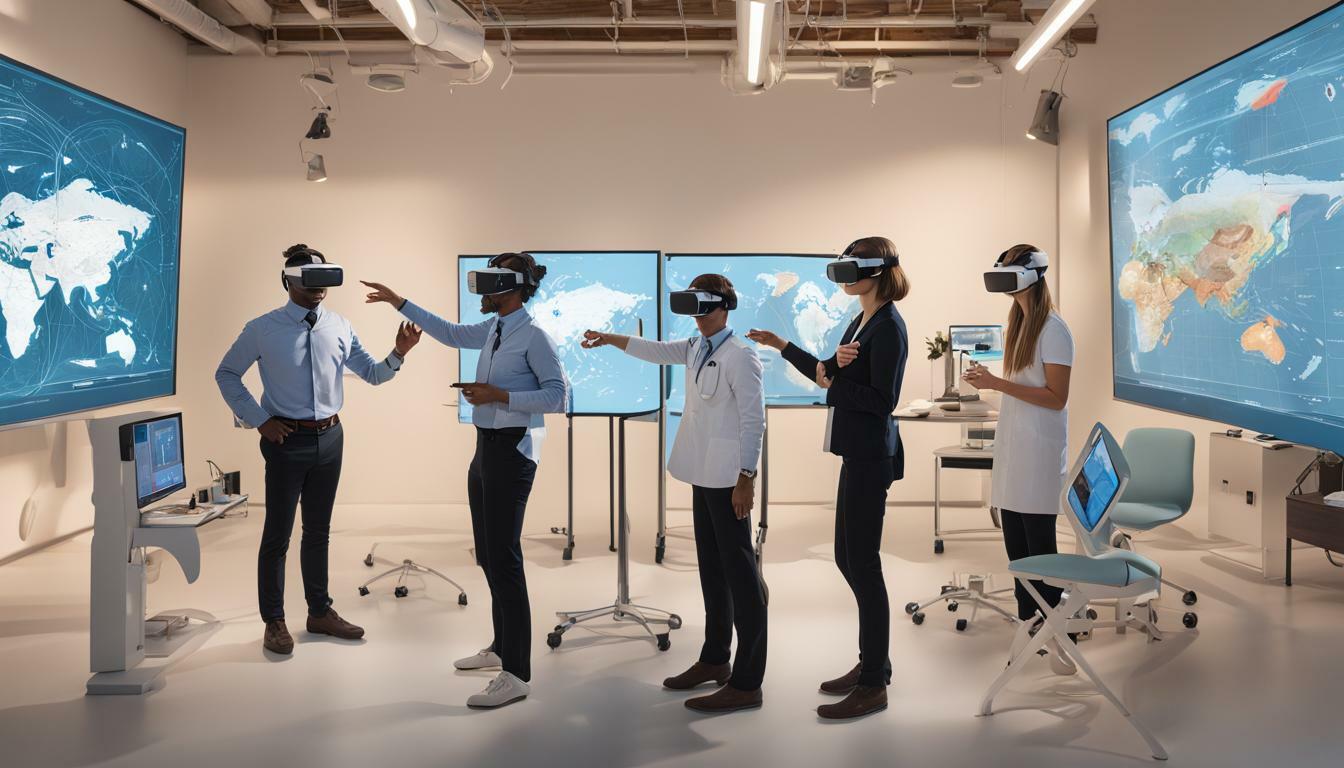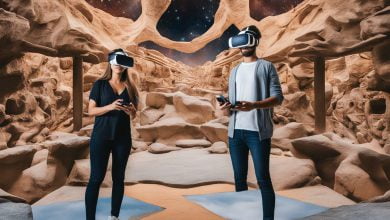
Welcome to the world of virtual reality (VR), where it’s not just about immersive gaming experiences. In recent years, VR has made significant strides in transforming real-world industries, including medicine, education, and business. Its impact has been felt in more ways than one, from enhancing healthcare outcomes to revolutionizing traditional teaching methods. Real-world applications of VR in medicine, education, and business are becoming increasingly prominent, ushering in a new era of innovative solutions. In this article, we will explore how VR is making a difference in healthcare, education, and business, and discuss future possibilities and challenges ahead.
Let’s start by taking a closer look at VR in healthcare. With its ability to simulate surgical procedures and provide training for healthcare professionals, virtual reality has become a valuable tool in the field of medicine. On the other hand, VR is revolutionizing traditional teaching methods and creating immersive learning experiences in education. Finally, VR is making an impact on the business world by improving employee training, product development, virtual meetings, and virtual showrooms. Keep reading to learn more about the real-world applications of VR in medicine, education, and business.
Virtual Reality in Medicine
Virtual reality (VR) is revolutionizing medical education and training, providing immersive experiences that simulate real-life scenarios. Medical professionals can now effectively practice complex procedures and surgeries with VR applications in medicine, reducing the risk during actual procedures. VR is also used in therapy and rehabilitation, creating new possibilities in patient care.
One of the most popular VR applications in medicine is surgical training. Trainees can now simulate surgeries on virtual patients before performing on real patients. By practicing a surgery multiple times, medical professionals can improve their skills and enhance patient outcomes. VR is being used to train medical professionals in a wide variety of fields, from dental procedures to invasive surgeries.
Virtual reality is being used to improve patient treatment as well. Doctors can create virtual environments to help patients with phobias and anxiety disorders. For example, a patient with a fear of heights can undergo virtual reality exposure therapy, allowing them to gradually overcome their fear in a controlled environment. Additionally, physical therapy and rehabilitation can be enhanced with VR, providing an immersive environment for patients to practice movements and exercises.
Real-world Examples
In one study, doctors used VR to treat burn patients by creating a virtual reality experience that allowed the patients to control a virtual snowball fight. By engaging in the activity, the patients distracted themselves from the pain and discomfort caused by the burns, promoting faster healing and recovery.
Another use case is the VR module developed by Oxford Medical Simulation to train medical staff on COVID-19 patient management. The simulation allows trainees to make decisions on patient care and manage resources in a realistic and immersive environment.
Overall, virtual reality is transforming the healthcare industry, providing new opportunities for surgeons, therapists, and patients alike.
Virtual Reality in Education
Virtual reality has been transforming the world of education, offering immersive experiences that can enhance learning in ways previously unimaginable. With the use of VR, educators can take students on virtual field trips, enable them to explore 3D models, and provide hands-on experiences that were once impossible.
One of the significant advantages of VR in education is that it engages students in active learning, making the learning process more interactive and enjoyable. With VR, students can view complex concepts as tangible objects, leading to increased understanding and retention of the material.
VR is also providing a new level of accessibility and inclusivity in education. With virtual simulations, students can experience activities that may not have been physically possible or safe for them. Additionally, VR can provide opportunities for students with disabilities to experience things they may not have been able to in the past.
Institutions are adopting VR for various applications, from enhancing traditional classroom learning to creating immersive museum experiences. VR is also being used in vocational training and simulated workplaces for job-specific skills training.
As VR technology continues to evolve, the possibilities for education are endless. VR is expected to revolutionize the way students learn, with personalized learning experiences, real-time collaboration, and global connectivity.
Virtual Reality in Business
Virtual reality has made a significant impact on the way businesses operate, enhancing productivity and customer engagement. One of the most significant applications of VR in business is employee training. Companies are leveraging VR technology to create immersive training experiences for employees, providing them with a safe and controlled environment to practice real-world situations. This has resulted in a reduction in training costs and increased efficiency.
Moreover, VR is revolutionizing product development by allowing designers to create and test prototypes in a virtual environment before moving on to physical production. This has not only reduced production costs but also shortened the design cycle, resulting in faster time-to-market.
Virtual reality is also transforming the way businesses conduct meetings and presentations. With VR, companies can hold virtual meetings with clients and employees from different locations, saving time and travel costs. Additionally, virtual showrooms are becoming increasingly popular in the automotive and real estate industries, providing customers with 3D virtual tours of products and properties.
Overall, virtual reality is transforming the way businesses operate, and its potential for growth and innovation continues to expand.
Overcoming Challenges and Future Possibilities
Despite the numerous benefits of virtual reality technology in healthcare, education, and business, there are several challenges that must be overcome for wider adoption. One of the biggest obstacles is the cost of implementing VR programs and equipment, which can be prohibitive for smaller organizations and institutions.
Accessibility is another issue, as not everyone has access to the necessary technology or skills to use it effectively. Furthermore, creating a user-friendly and immersive experience is essential for the success of VR applications, and this requires a significant investment in design and development.
However, despite these challenges, there are still numerous use cases for VR in medicine, education, and business. In medicine, VR is being used for surgical simulations, mental health therapy, and pain management. In education, VR is allowing students to experience historical events, explore new worlds, and understand complex concepts in a more engaging way. In business, VR is being used for employee training, product design, and customer engagement.
Looking towards the future, the possibilities of VR in these sectors are vast. Advancements in technology such as haptic feedback, improved graphics, and artificial intelligence will only enhance the user experience and lead to even more sophisticated applications. Areas such as remote medical procedures and virtual offices are also potential growth areas for VR.
Overall, while there are challenges to overcome, the potential benefits of virtual reality technology in medicine, education, and business are too significant to ignore. By developing innovative solutions and working to improve accessibility and affordability, the future of VR in these sectors looks bright.
Ethical and Legal Considerations
As with any emerging technology, virtual reality in medicine, education, and business comes with its own set of ethical and legal considerations that need to be addressed.
In the medical field, patient privacy is a major concern, as VR technology involves collecting and storing patient data. Ensuring the security and confidentiality of this data is crucial to avoid any potential breaches. Additionally, there are ethical considerations related to the use of VR in patient treatment, as it is essential to ensure that patients understand the technology involved and give their informed consent before using it.
In education, there are concerns about the potential misuse of VR technology, as it may lead to addiction or the creation of false realities. It is important to establish guidelines that ensure the safe and responsible use of VR in the classroom.
The use of VR in the business world also raises concerns about data privacy and security. The collection of user data in virtual environments may lead to privacy breaches, which must be addressed through appropriate security measures. Additionally, there are legal considerations related to the use of VR in advertising and marketing, as it is important to ensure that virtual experiences are not misleading or deceptive.
To address these concerns, it is crucial to establish a framework of regulations and guidelines that promote the safe and ethical use of virtual reality technology in medicine, education, and business. This includes measures to protect user privacy, ensure data security, and prevent any potential misuse of VR technology.
Conclusion
Virtual reality technology has the potential to transform the way we approach medicine, education, and business. From improving healthcare outcomes to creating immersive learning experiences and enhancing customer engagement, VR is paving the way for new opportunities and growth in these sectors. However, with these opportunities come ethical and legal considerations, such as patient privacy and data security. It is important for guidelines and regulations to be established to ensure responsible use of VR technology.
Looking ahead, advancements in technology will continue to drive innovation and growth in virtual reality. Despite the challenges faced in implementing VR in medicine, education, and business, the benefits cannot be ignored. As the technology evolves, so too will its applications and possibilities. It is an exciting time for the world of virtual reality, and we can expect to see even greater advancements and impacts in the future.








